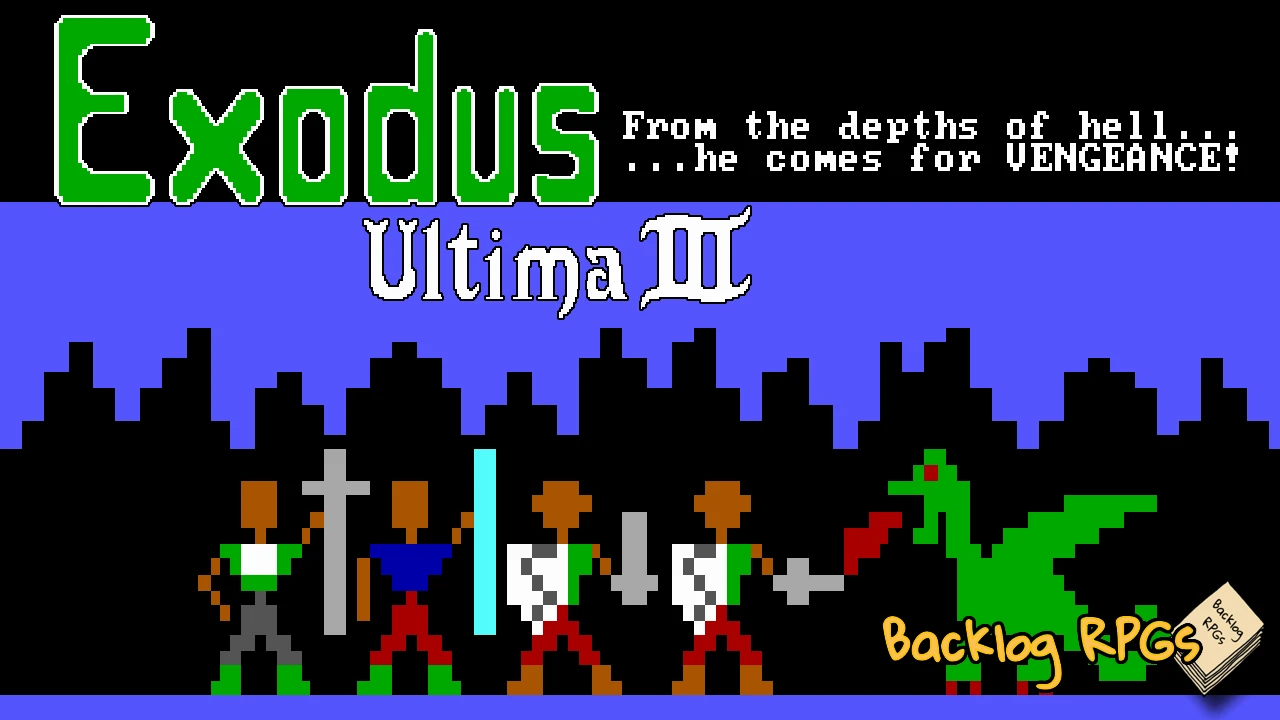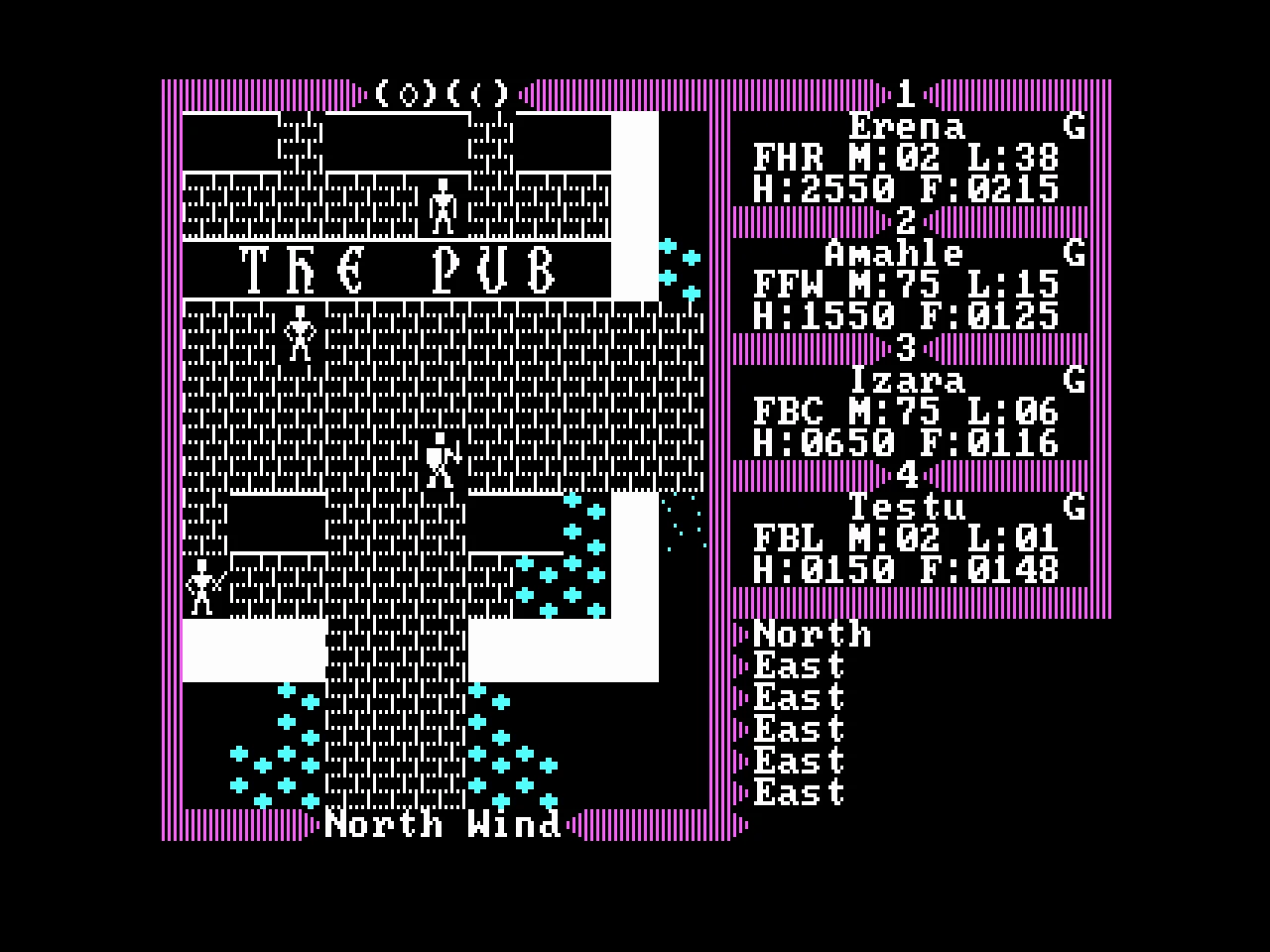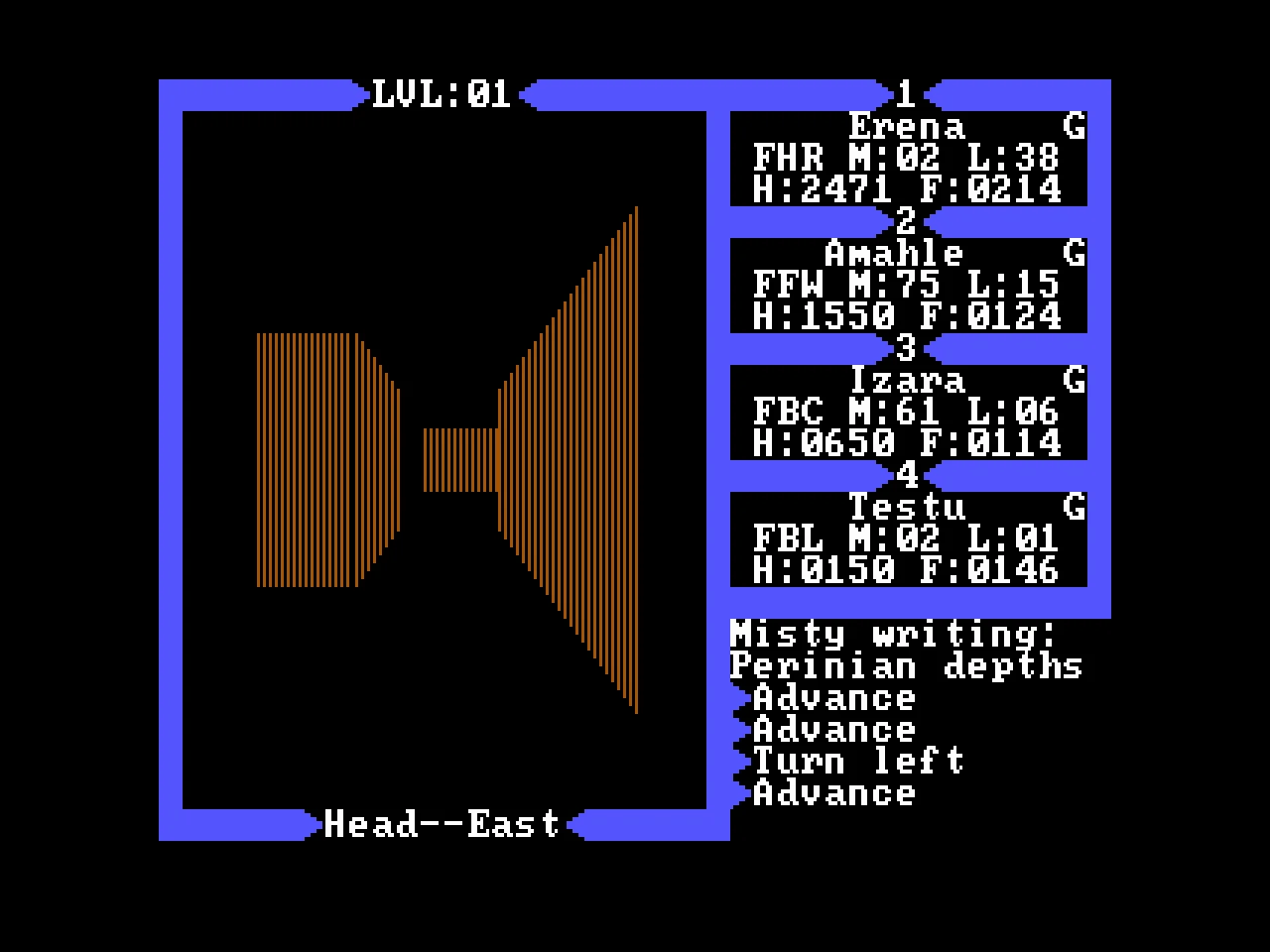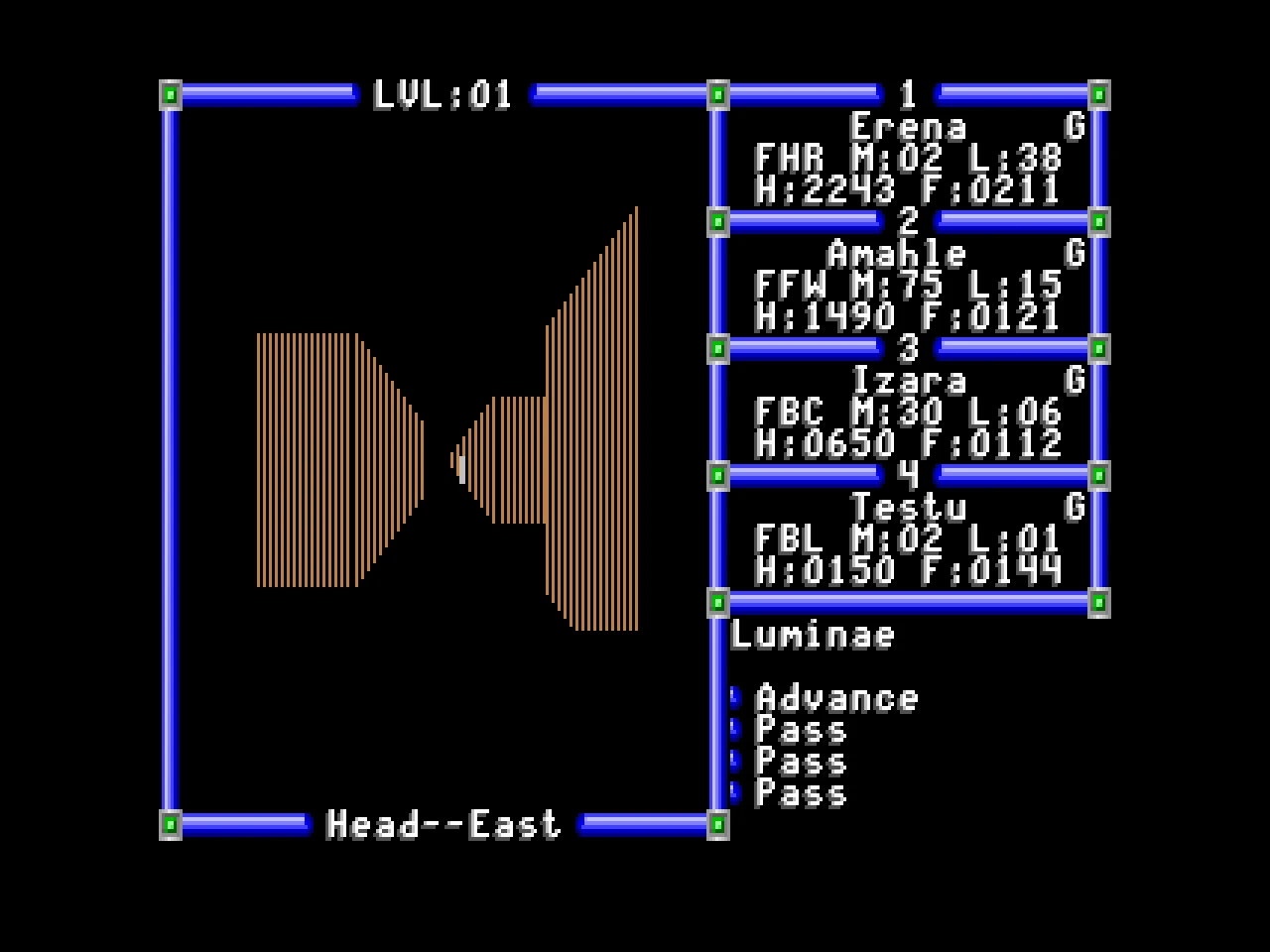Introduction
So it’s the beginning of November and we are finally playing Ultima III: Exodus, finishing the so-called Age of Darkness trilogy, composed of the first three Ultima games. Exodus was originally released in 1983 for the Apple II (its development platform), C64, 8-bit Atari and IBM PC. Again, the IBM was the worst port and the one we are playing today.
Exodus was the first game published by Origins System, Inc., the company Richard Garriot, Ultima’s creator, founded with his brother and father. After two bad experiences working with well-established publishers, Garriot felt that tackling production and distribution was a necessity not only to keep his independence as a developer, but to avoid disputes over profits and royalties.
It was a risky move since the company was founded near the infamous video game crash of 1983, usually attributed to the E.T. game by Atari. I don’t think it’s necessary to say that’s an oversimplification of the event, as a major industry crash would not be caused only by a game failing its sales goals. Still, Exodus was a success and guaranteed Origins survival and growth.
Like its predecessor, Ultima III came with a few feelies: The Book of Play, the game’s manual; The Ancient Liturgy of Truth, clerics spell list; The Book of Amber Runes, wizards spell list; a cloth map; and an advertisement for Secrets of Sosaria, a clue book, originally sold separately.
Like the other digital releases, all these books are now supplied in digital format, but the pdf files look terrible and sometimes are hard to read. The clue book is specially bad. I was very disappointed by this lack of care.
The game was a big improvement from its predecessor, featuring a party system, revamped combat, improved graphics (except for the IBM PC), and a soundtrack (that was considered a novelty at the time). But is it still worth playing? Let’s find out.
The Narrative
After The Stranger defeated Minax, Sosaria stayed in peace for 20 years. Unfortunately, its inhabitants can’t have a break, as in the middle of the ocean a volcanic island appeared. There, amidst the molten lava looms a dark presence from a castle. Later on the Great Earth Serpent emerged from the bottom of the ocean, while monsters reappeared all over Sosaria.
A hint of the nature of this new menace was found in the ruins of Shadowguard, Minax’s fortress. A fragment of a manuscript telling about her union with Mondain, and the creation of something that could be a Man, a Monster, or a Daemonm (the box art is a bit misleading, don’t believe on it!). After investigating the matter, Lord British sent a call for heroes to fight this new menace, only known as Exodus. And so The Stranger comes back one more time, but now followed by three allies.
Like the previous games, besides the backstory on the manual, there is no actual plot, only a few events the player needs to complete to arrive at the final confrontation. No important NPC, no interesting event, no dramatic scenes. But that’s fine, as it was the standard of the time. Just don’t go play expecting a gripping narrative.
Presentation
Like in Ultima II, the DOS port of Ultima III has poor graphics and no soundtrack, as at the time IBM machines were quite inferior to the Apple II and the Commodore 64 in terms of graphics and sound. Unfortunately, that’s the version most modern players will have access since it’s the one GOG and EA distribute.
Thankfully, the developers at The Exodus Project have done an excellent patch that changes graphics, adds the soundtrack, and offer other modifications. It also comes with the Sosaria mod, that changes the overworld map to resemble the continent from Ultima I.
Original CGA (4-color)
2 - CGA Composite (16-color)
3 - EGA (16-color)
4 - VGA (256-color)
I played the game in 16 color EGA as it looked better to me, but you may choose what’s easier on your eyes.
Ultima III has an enjoyable soundtrack, with seven original compositions: Wanderer, Towne, Castle, Dungeon, Combat, Shopping and Exodus’ Castle - The Isle of Fire. At the time it still was a novelty on the platform, since it had limited capabilities in this regard. According to Through the Moongate. The Story of Richard Garriott, Origin Systems Inc. and Ultima: Part 1 - From Akalabeth to Ultima VI, by Andrea Contato, to be able to play the soundtrack on an Apple 2, the computer would have to be equipped with two expansion cards: the Sweet Micro Systems Mockingboard, which gave it better sound capabilities, and the Language card, which gave its users more 16K of RAM. Yet even with these accessories the developers had to put a lot of effort thanks to other technical limitations from the Apple II platform.
Mechanics
Altogether, Ultima III is a better experience than its predecessors. The plot is still cryptic if compared to modern RPGs, but thanks to its clue book it isn’t hard to find your way around Sosaria. But to make things more difficult, there is no conventional map, as the only one you can find in-game don’t identify any point of interest. The original cloth map doesn’t identify cities or dungeons too, but you could mark these locations with push pins or similar office supplies. If you have the digital release, you can draw all over its scanned counterpart if you want to feel like it’s 1983. Otherwise, you can seek better maps online.
There were a few changes on the overworld. Now if you enter a forest area your vision will become limited, making it hard to explore. It also happens inside cities, what’s really annoying. The developers also cut most of the vehicles available, leaving only horses (that you can also fight) and the frigate. Traveling by the latter became a shore thanks to the addition of real wind. Now it will blow from a specific direction, what stops you from going through that path, or not blow at all, leaving your ship stuck while you press the space bar to pass the time. I hate it. Finally, there are a few portals called moon gates that are used to transport to different places around the world.
Even with those problems, I genuinely enjoyed exploring the world and marking places of interest on the scanned map instead of searching for a complete one. I also had some fun putting together clues and save scumming to get the necessary information from oracles and bartenders to not lose my money.
As for dungeons, the developers finally dropped the wireframe aesthetics for a more textured one. They are also better integrated on the game’s plot, as you need to explore at least a few of them to finish the game. The clue book has maps for all the dungeons, what helps a lot with finding secret passages.
Party Hard
Differently from Garriot’s last three games, Ultima III finally has a party system. You can create up to 20 characters and form parties of 4, but it’s possible to play with smaller parties or even with only one character if you want to continue living the solo adventures of The Stranger. If for any reason you feel unhappy with a character, you can reform your group of heroes every time the game is loaded.
When creating a character, you can choose between five races (Human, Elf, Dwarf, Bobbit, and Fuzzy) and eleven professions (Fighter, Cleric, Wizard, Thief, Paladin, Barbarian, Lark, Illusionist, Druid, Alchemist, and Ranger). Each one has their pros and cons, but it’s easy to create well-balanced parties.
Your characters will level up after every 100 points of experience, what only increases their max HP after you speak with Lord British. Unfortunately, only the character that delivers the finishing blow to an enemy will receive experience, what makes acquiring experience rather time consuming.
Increasing stats is more convoluted than in Ultima II, as first you will need to discover where to go and second, pay up the price of 100 gold to rise in 1 point an attribute. So, prepare yourself to talk to NPCs and find the necessary clues while grinding to have enough money. Even if it makes more sense plotwise, I still hate paying to raise attributes. It just forces you to replay the same battles over and over without a reasonable reason.
Inventory management is a minor annoyance, as it involves a lot of commands. As an example, one of my characters was equipped with a leather armor, but also had a spare one that I wanted to move to another character. First I had to unequip the donor character, then press H to hand out an object, then select the donor, then the receiver, then Armor, then which armor, and finally the quantity. After all these steps, I had to equip both characters with the armor sets.
Battle System
As a consequence of having a party combat was revamped, becoming a tactical turn-based system, in which the player characters and enemies move around a grid-like battlefield. Characters can attack using ranged or close-range weapons, or a combination of both if you have patience to keep switching between them mid fight magical users can use spells to recover HP, attack or cure poisoning.
Battles will start randomly as you explore dungeons, while on the overworld you must touch a monster sprite.
The changes on the game’s battle system are more than welcome, since I never felt fighting in previous installments was involving or fun. Yes, combat is bit slow now and can become boring if you have a lot of enemies on the map and no way to quickly kill them. The enemy AI also isn’t the best, usually relying more on having more enemies than on smart moves. Yet the combat is a lot better than just pushing A to attack, as you have different weapons and spells to try out and strategizing how you place your characters on the battlefield to minimize damage is a necessity when trying to reach the lower levels of a dungeon. Overall, it was a great step forward.
Final Thoughts
Ultima III is a big improvement over the other games, as it integrates better all its different components in a seamless experience when compared to its predecessors. The world feels more cohesive and there are no wasted locations, as most of them offer something useful to the player. It still is a bit cryptic if compared to modern games, but thanks to the clue book it’s more playable if you enjoy exploring 2d pixel worlds. The possibility of creating different characters and reform your party at any moment is a good addition, as is its new battle system, that offers more engagement than on the last games. Overall, the better game of the original trilogy, and the one to try if want to feel the beginnings of the Ultima franchise.
Final opinion: Recommended if you feel like playing just one of the earlier Ultima titles. It’s also a fun game to have on your phone if you like using DOSBox on it.


















